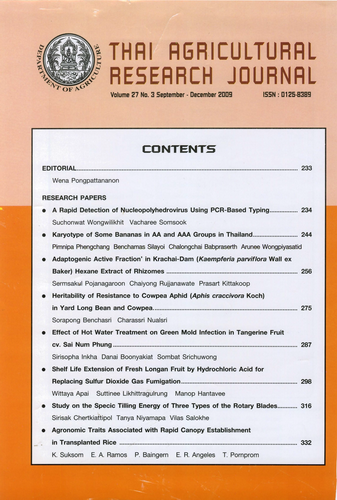Study on the Specic Tilling Energy of Three Types of the Rotary Blades
DOI:
https://doi.org/10.14456/thaidoa-agres.2009.22Keywords:
specific tilling energy, Japanese C-shaped blade, European L-shaped blade, European C-shaped blade, sandy loam soil, clay soilAbstract
The aim of the study was to compare the specific tilling energy of blade namely the Japanese C-shaped blade, the European L-shaped and the European C-shaped. The experiments were carried out in laboratory using soil bin with sandy loam and clay soils at forward speeds of 0.034, and 0.069m/s and rotational speeds of 150, 218, 278, and 348 rpm at 11.3% (d.b.) moisture content of soil under down-cut process. Moreover, the effects of rotational speed of rotary blades, forward speed, tilling depth and dry bulk density of soil were also studied. For all tested rotary blades, the tilling energy in clay soil was higher than in sandy loam soil. For the Japanese C-shaped blade in sandy loam soil, the specific tilling energy at 1.19 g/cm³ dry bulk density of soil was 2.6-11.3% higher than at 1.01 g/cm³ dry bulk density of soil. The tests of all rotary blades in clay soil showed that the specific tilling energy at 1.19 g/cm³ dry bulk density of soil was 2.6-11.3% higher than at 1.01 g/cm³ dry bulk density of soil. The tests of all rotary blades in clay soil showed that the specific tilling energy increased with increase in the tilling depth from 12 to 14 cm. In case of the tests in sandy loam soil at 1.01 g/cm³ dry bulk density of soil, the average of specific tilling energy requirement of Japanese C-shaped blade was 2.0-4.0 and 1.0-1.9 times higher than the European L-shaped and European C-shaped blades, respectively. For the experiments in clay soil at 1.01 g/cm3 dry bulk density of soil, the specific tilling energy requirement of the Japanese C-shaped blade was 2.8-2.9 times and 1.4-1.6 times higher than the European L-shaped and the European C-shaped blades, respectively.
Downloads
Published
How to Cite
Issue
Section
License
Copyright (c) 2017 วารสารวิชาการเกษตร (Thai Agricultural Research Journal)

This work is licensed under a Creative Commons Attribution-NonCommercial-NoDerivatives 4.0 International License.
Thai Agricultural Research Journal



